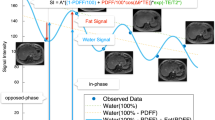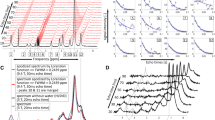Abstract
Objective
To validate a magnitude-based method for fat volume fraction (FVF) quantification in the liver without any dominant component ambiguity problems and with the aim of transferring this method to any imaging system (clinical fields of 1.5 and 3.0 T).
Methods
MR imaging was performed at 1.5 and 3.0 T using a multiple-angle multiple-gradient echo sequence. A quantification algorithm correcting for relaxation time effects using a disjointed estimation of T1 and T2* of fat and water and accounting for the NMR spectrum of fat was developed. Validations were performed on fat–water emulsion at 1.5 and 3.0 T and compared with 1H-MRS. This was followed by a prospective in-vivo comparative study on 28 patients with chronic liver disease and included histology.
Results
Phantom study showed good agreement between MRI and MRS. MR-estimated FVF and histological results correlated strongly and FVF allowed the diagnosis of mild (cutoff = 5.5 %) and moderate steatosis (cutoff = 15.2 %) with a sensitivity/specificity of 100 %.
Conclusion
FVF calculation worked independently of the field strength. FVF may be a relevant biomarker for the clinical follow-up of patients (1) with or at risk of NAFLD (2) of steatosis in patients with other chronic liver diseases.
Key points
• Non-invasive techniques to diagnose non-alcoholic fatty liver diseases (NAFLD) are important.
• Liver fat volume fraction quantified using MRI correlates well with histology.
• Fat volume fraction could be a relevant marker for NAFLD clinical follow-up.
• Disjointed relaxation time estimation could potentially identify factors contributing to NAFLD.







Similar content being viewed by others
References
Szczepaniak L, Nurenberg P, Leonard D et al (2005) Magnetic resonance spectroscopy to measure hepatic triglyceride content: prevalence of hepatic steatosis in the general population. Am J Physiol Endocrinol Metab 288:462–468
Ratziu V, Bellentani S, Cortez-Pinto H et al (2010) A position statement on NAFLD/NASH based on the EASL 2009 special conference. J Hepatol 53:372–384
Bedogni G, Miglioli L, Masutti F et al (2005) Prevalence of and risk factors for nonalcoholic fatty liver disease: the Dionysos nutrition and liver study. Hepatology 42:44–52
Reilly JJ (2006) Diagnostic accuracy of the BMI for age in paediatrics. Int J Obes 30:595–597
Stamatakis E, Primatesta P, Chinn S, Rona R, Falascheti E (2005) Overweight and obesity trends from 1974 to 2003 in English children: what is the role of socioeconomic factors? Arch Dis Child 90:999–1004
Harrison SA, Neuschwander-Tetri BA (2004) Non alcoholic fatty liver disease and nonalcoholic steatohepatitis. Clin Liver Dis 8:861–879
Sanyal AJ, Banas C, Sargeant C et al (2006) Similarities and differences in outcomes of cirrhosis due to nonalcoholic steatohepatitis and hepatitis C. Hepatology 43:682–689
Guzman G, Brunt EM, Petrovic LM et al (2008) Does nonalcoholic fatty liver disease predispose patients to hepatocellular carcinoma in the absence of cirrhosis? Arch Pathol Lab Med 132:1761–1766
Lok AS, Everhart JE, Chung RT et al (2009) Evolution of hepatic steatosis in patients with advanced hepatitis C: results from the hepatitis C antiviral long-term treatment against cirrhosis (HALT-C) trial. Hepatology 49:1828–1837
Piccinino F, Sagnelli E, Pasquale G et al (1986) Complications following percutaneous liver biopsy: a multicentre retrospective study on 68,276 biopsies. J Hepatol 2:165–173
Cadranel JF, Rufat P, Degos F et al (2000) Practices of liver biopsy in France: results of prospective nationwide survey. Hepatology 32:477–481
Poniachik J, Bernstein DE, Reddy KR et al (1996) The role of laparoscopy in the diagnosis of cirrhosis. Gastrointest Endosc 43:568–571
Bedossa P, Dargere D, Paradis V (2003) Sampling variability of liver fibrosis in chronic hepatitis C. Hepatology 38:1449–1457
El-Badry AM, Breitenstein S, Jochum W et al (2009) Assessment of hepatic steatosis by expert pathologists: the end of a gold standard. Ann Surg 250:691–697
Wong WF, Northrup SR, Herrick RC et al (1994) Quantification of lipid in biological tissue by chemical shift magnetic resonance imaging. Magn Reson Med 32:440–446
Bohte AE, van Werven JR, Bipat S et al (2011) The diagnostic accuracy of US, CT, MRI and 1H MRS for the evaluation of hepatic steatosis compared with liver biopsy: a meta-analysis. Eur Radiol 21:87–97
Rinella ME, McCarthy R, Thakrar K et al (2003) Dual-echo, chemical shift gradient-echo magnetic resonance imaging to quantify hepatic steatosis: implications for living liver donation. Liver Transpl 9:851–856
Pacifico L, Celestre M, Anania et al (2007) MRI and ultrasound for hepatic fat quantification: relationships to clinical and metabolic characteristics of pediatric nonalcoholic fatty liver disease. Acta Paediatr 96:542–547
Schuchmann S, Weigel C, Albrecht L et al (2007) Non-invasive quantification of hepatic fat fraction by fast 1.0, 1.5 and 3.0 T MR imaging. Eur J Radiol 62:416–422
Cowin GJ, Jonsson JR, Bauer JD et al (2008) Magnetic resonance imaging and spectroscopy for monitoring liver steatosis. J Magn Reson Imaging 28:937–945
Borra RJ, Salo S, Dean K et al (2009) Nonalcoholic fatty liver disease: rapid evaluation of liver fat content with in-phase and out-of-phase MR imaging. Radiology 250:130–136
Mennesson N, Dumortier J, Hervieu V et al (2009) Liver steatosis quantification using magnetic resonance imaging: a prospective comparative study with liver biopsy. J Comput Assist Tomogr 672–677
Leporq B, Ratiney H, Cavassila S et al (2010) Fat content quantification errors using multiple gradient echo imaging: a phantom and simulation study. ISMRM-ESMRMB Joint Annual Meeting proceedings
Guiu B, Petit JM, Loffroy R et al (2009) Quantification of liver fat content: comparison of triple-echo chemical shift gradient-echo imaging and in vivo proton MR spectroscopy. Radiology 250:95–102
Hussain HK, Chenevert TL, Londy FJ et al (2005) Hepatic fat fraction: MR imaging for quantitative measurement and display—early experience. Radiology 237:1048–1055
Bydder M, Yokoo T, Hamilton G et al (2008) Relaxation effects in the quantification of fat using gradient echo imaging. Magn Reson Imaging 26:347–359
Yokoo T, Bydder M, Hamilton G et al (2009) Nonalcoholic fatty liver disease: diagnostic and fat-grading accuracy of low-flip-angle multi-echo gradient-recalled-echo MR imaging at 1.5 T. Radiology 251:67–76
Yu H, Shimakawa A, McKenzie CA et al (2008) Multi-echo water-fat separation and simultaneous R2* estimation with multi-frequency fat spectrum modeling. Magn Reson Med 60:1122–1134
Yu H, Shimakawa A, Hines CD et al (2011) Combination of complex-based and magnitude-based multi-echo water-fat separation for accurate quantification of fat-fraction. Magn Reson Med 66:199–206
Meisamy S, Hines C, Hamilton G, et al. Quantification of hepatic steatosis using T1 independent, T2* corrected MRI with spectral modeling of fat: a blinded comparison with MR spectroscopy. Radiology 258:767–775
Hines C, Frydrychowicz A, Hamilton G et al (2011) T1 independent, T2* corrected chemical shift based fat-water separation with multi-peak fat spectral modeling is an accurate and precise measure of hepatic steatosis. J Magn Reson Imaging 33:873–881
Hamilton G, Yokoo T, Bydder M et al (2011) In vivo characterization of the liver fat 1H MR spectrum. NMR Biomed 24:784–790
Reeder SB, Hines CD, Yu H et al (2009) On the definition of fat-fraction for in vivo fat quantification with magnetic resonance imaging. ISMRM proceedings
Ratiney H, Bucur A, Sdika M et al (2008) Effective Voigt model estimation using multiple random starting values and parameter bounds settings for in vivo hepatic 1H Magnetic Resonance Spectroscopy data. IEEE International Symposium on Biomedical Imaging proceedings
French METAVIR Cooperative Study Group (1994) Intraobserver and interobserver variations in liver biopsies in patients with chronic hepatitis C. Hepatology 20:15–20
Brunt EM, Janney CG, Di Bisceglie AM et al (1999) Nonalcoholic steatohepatitis: a proposal for grading and staging the histological lesions. Am J Gastroenterol 94:2467–2474
De Bazelaire CM, Duhamel GD, Rofsky NM et al (2004) MR imaging relaxation times of abdominal and pelvic tissues measured in vivo at 3.0 T: preliminary results. Radiology 230:652–659
Heye T, Yang SR, Bock M et al (2012) MR relaxometry of the liver: significant elevation of T1 relaxation time in patients with liver cirrhosis. Eur Radiol 22:1224–1232
Sirlin CB, Reeder SB (2010) Magnetic resonance imaging quantification of liver iron. Magn Reson Imaging Clin N Am 18:359–381
Reeder SB, Cruite I, Hamilton G et al (2011) Quantitative assessment of liver fat with magnetic resonance imaging and spectroscopy. J Magn Reson Imaging 33:873–881
Thomsen C, Christoffersen P, Henriksen O, Juhl E (1990) Prolonged T1 in patients with liver cirrhosis: an in vivo MRI study. Magn Reson Imaging 8:599–604
Wood JC, Enriquez C, Ghugre N et al (2005) MRI R2 and R2* mapping accurately estimates hepatic iron concentration in transfusion-dependent thalassemia and sickle cell disease patients. Blood 106:1460–1465
Bonkovsky HL, Jawaid Q, Tortorelli K et al (1999) Non-alcoholic steatohepatitis and iron: increased prevalence of mutations of the HFE gene in non-alcoholic steatohepatitis. J Hepatol 3:421–429
Stark DD, Bass NM, Moss AA et al (1983) Nuclear magnetic resonance imaging of experimentally induced liver disease. Radiology 148:743–751
Acknowledgments
This work was conducted in the framework of the LabEX PRIMES. The authors thank Anoop Ramgolam for help in editing the manuscript and Hervé Saint-Jalmes for providing lipid emulsions.
Author information
Authors and Affiliations
Corresponding author
Rights and permissions
About this article
Cite this article
Leporq, B., Ratiney, H., Pilleul, F. et al. Liver fat volume fraction quantification with fat and water T1 and T2* estimation and accounting for NMR multiple components in patients with chronic liver disease at 1.5 and 3.0 T. Eur Radiol 23, 2175–2186 (2013). https://doi.org/10.1007/s00330-013-2826-x
Received:
Revised:
Accepted:
Published:
Issue Date:
DOI: https://doi.org/10.1007/s00330-013-2826-x




